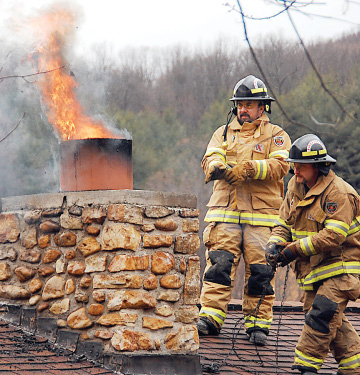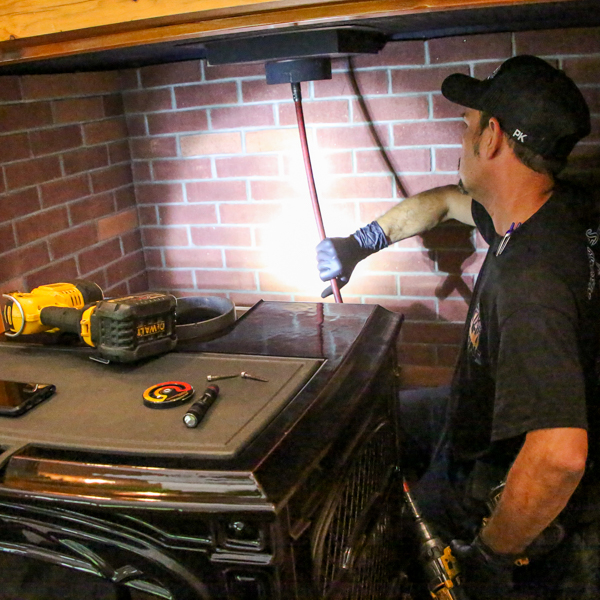How to Put Out a Chimney Fire
Many Americans love using their fireplaces because they provide warmth and an atmosphere you can’t get with other heating systems. However, the greatest fear fireplace owners have is a chimney fire. According to data published by the National Fire Protection Association, nearly 30% of home heating fires involved fireplaces or chimneys between 2014 and 2018. In this post, we look at the primary cause of chimney fires, what to do in the event of one, and how to prevent them.
 The Primary Cause of Chimney Fires
The Primary Cause of Chimney Fires
One of the most common causes of chimney fires is a creosote build-up inside the chimney. Creosote is a by-product of burning wood and builds up on the walls of the chimney, especially if the chimney isn’t thoroughly cleaned regularly. When creosote ignites, it can cause a scorching and intense fire that can quickly spread to the rest of the house. Many people think the temperature in the chimney would have to be considerably hot to ignite creosote, but that’s not the case. According to the Chimney Safety Institute of America,
Creosote can ignite at temperatures as low as 451 degrees F (for context, a fire in your fireplace can burn in excess of 450 degrees F), and even just a 1/8” buildup of creosote is considered high enough to cause a chimney fire.
Another common cause of chimney fires is leaving ashes in the fireplace. Ashes can retain heat for a long time, and if left in the fireplace, they can eventually ignite something else in the fireplace or even start another fire in the chimney. It’s essential to make sure all ashes are removed from the fireplace after each use; this isn’t something that you should put off to do.
Chimney blockages also cause chimney fires. Whether it’s bird nests or debris, flue blockages cause heat and gas to build inside the chimney, which can ignite creosote or the obstruction itself.
Finally, be aware of the type of wood you burn in your fireplace. Softwoods such as pine or cedar burn much hotter than hardwoods like oak or hickory and can create a lot of sparks. These sparks can easily ignite any build-up of creosote on the walls of your chimney.
Recognizing a Chimney Fire
Chimney fires are obvious from outside the house, but they may not be so obvious when you’re inside. However, there are telltale warning signs that something is seriously wrong.
Signs to watch for are:
Loud cracking noises from the flue
Thick, dense smoke spilling out from the fireplace
Flaming bits falling into the fireplace
Roaring sound like being in an airplane
How to Put Out a Chimney Fire
While it’s possible to put a chimney fire out yourself, call emergency services as soon as you notice the problem and then follow these steps.
Get Everyone to Safety
Once you determine you have a chimney fire, the most important thing to do is get everyone out of the house to safety and contact the fire department. Even if you put out the fire, it’s wise to have the fire department on hand to be safe and ensure the danger is gone.
Cut Off the Fuel Supply
Once everyone is out of the house and safe, and you feel you can get things under control, close the damper to starve the fire of oxygen. If you have an ABC fire extinguisher, put out the fire in the firebox; if not, try using sand, salt, or baking soda.
Use the Hose
While waiting for the fire department to arrive, turn the hose on the outside of the chimney to dampen it and lower the temperature.
Clean the Firebox
Finally, remove debris from the firebox with a shovel, put it into a metal bucket, and take it outside. Once there, use the hose to dampen the debris.
We’ve said it before, but it bears repeating, you should only attempt to put out a chimney fire if it’s safe. If you have a fast-burning fire that’s getting out of control quickly, don’t take chances; let the fire department handle it.
How to Prevent Chimney Fires
The good news is that most chimney fires are preventable, so if you follow these steps, you’ll likely never have to deal with this nightmare scenario.
Schedule Annual Cleaning
Because most chimney fires happen because of blockages or creosote buildup, it’s essential to schedule annual cleaning and maintenance by a certified chimney specialist. Although prices vary, the average cost of chimney cleaning is $250, which is a small price to pay compared to the damage and trauma caused by a home fire.
Burn Seasoned Firewood
Seasoned firewood produces less smoke than unseasoned wood because it has less moisture in it. Experts recommend that you dry firewood for six months to a year before using it. Furthermore, avoid burning evergreens because they produce more sparks than hardwoods, also another risk of a fire.
Keep Your Damper Open
A hot, healthy fire needs oxygen, so you must keep your damper wide open when using your fireplace. Restricting airflow causes the fire to “struggle” to burn, creating more smoke, and more creosote.
Tens of thousands of homeowners use their fireplaces every season without incident because they take the necessary precautions. With a little care and forethought, you can enjoy a warm, cozy fire year after year without fear.
 Call the Fireplace Experts at Fire N Stone
Call the Fireplace Experts at Fire N Stone
Fire N Stone is a full-service fireplace, chimney, and custom stone company, serving residents throughout Tilton, NH.
We’re family owned and operated and offer certified chimney sweeping, inspection, maintenance, fireplace, and stove sales and installation, custom stone work, and more. From frame to finish, we do it all. Contact us at 603-293-4040.





